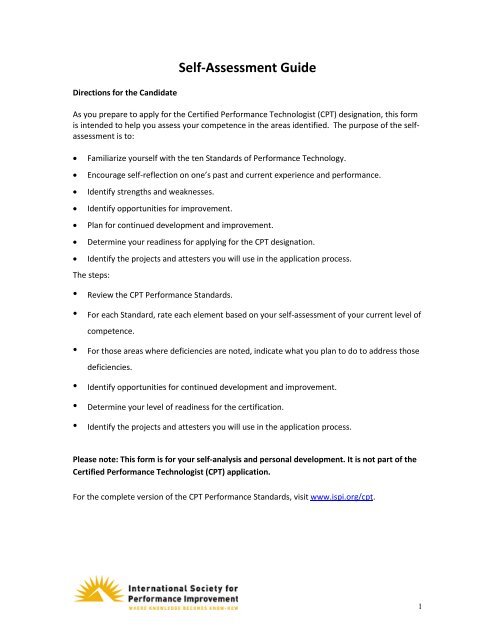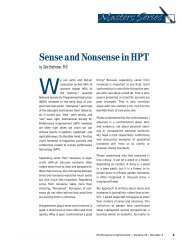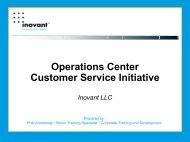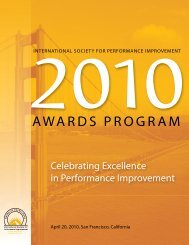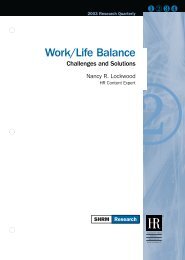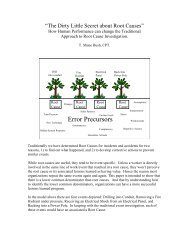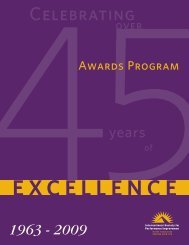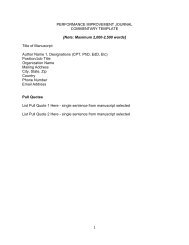Self Assessment Guide - International Society for Performance ...
Self Assessment Guide - International Society for Performance ...
Self Assessment Guide - International Society for Performance ...
Create successful ePaper yourself
Turn your PDF publications into a flip-book with our unique Google optimized e-Paper software.
<strong>Self</strong>-<strong>Assessment</strong> <strong>Guide</strong><br />
Directions <strong>for</strong> the Candidate<br />
As you prepare to apply <strong>for</strong> the Certified Per<strong>for</strong>mance Technologist (CPT) designation, this <strong>for</strong>m<br />
is intended to help you assess your competence in the areas identified. The purpose of the selfassessment<br />
is to:<br />
• Familiarize yourself with the ten Standards of Per<strong>for</strong>mance Technology.<br />
• Encourage self-reflection on one’s past and current experience and per<strong>for</strong>mance.<br />
• Identify strengths and weaknesses.<br />
• Identify opportunities <strong>for</strong> improvement.<br />
• Plan <strong>for</strong> continued development and improvement.<br />
• Determine your readiness <strong>for</strong> applying <strong>for</strong> the CPT designation.<br />
• Identify the projects and attesters you will use in the application process.<br />
The steps:<br />
• Review the CPT Per<strong>for</strong>mance Standards.<br />
• For each Standard, rate each element based on your self-assessment of your current level of<br />
competence.<br />
• For those areas where deficiencies are noted, indicate what you plan to do to address those<br />
deficiencies.<br />
• Identify opportunities <strong>for</strong> continued development and improvement.<br />
• Determine your level of readiness <strong>for</strong> the certification.<br />
• Identify the projects and attesters you will use in the application process.<br />
Please note: This <strong>for</strong>m is <strong>for</strong> your self-analysis and personal development. It is not part of the<br />
Certified Per<strong>for</strong>mance Technologist (CPT) application.<br />
For the complete version of the CPT Per<strong>for</strong>mance Standards, visit www.ispi.org/cpt.<br />
1
10 CPT Per<strong>for</strong>mance Standards<br />
STANDARD 1: Focus on Results or Outcomes<br />
Competent practitioners are focused on results throughout their assignments. They are not<br />
predisposed to a set of solutions. They apply their knowledge of what is required <strong>for</strong><br />
per<strong>for</strong>mance at all levels.<br />
Standard 2: Take a Systemic View<br />
Competent practitioners take a systemic view of their work. This requires them to<br />
identify the subsystems that make up the total organization. They look <strong>for</strong> and<br />
recognize that a change in one area will impact other areas. They consider how the<br />
dynamics in society, the marketplace, workplace, work, and workers affect the desired<br />
outcomes.<br />
Standard 3: Add Value<br />
Competent practitioners add value by using their expertise to facilitate the process in ways that<br />
result in better decisions, higher quality work by their team, and a higher quality end product.<br />
Standard 4: Work in Partnership with Clients and Stakeholders<br />
Competent practitioners collaborate with clients and stakeholders. This means that you<br />
incorporate the appropriate stakeholders, experts, and specialists as part of the team, involving<br />
them as necessary.<br />
Standard 5: Determine Need or Opportunity<br />
Competent practitioners design and conduct investigations to find out the difference between<br />
the current and the desired per<strong>for</strong>mances (the per<strong>for</strong>mance gap).<br />
Standard 6: Determine Cause<br />
Competent practitioners design and conduct investigations to find out why a gap exists between<br />
the current and desired per<strong>for</strong>mances. They look <strong>for</strong> the underlying causes.<br />
Standard 7: Design Solutions including Implementation and Evaluation<br />
Competent practitioners design solutions and the plan to implement them.<br />
Standard 8: Ensure Solutions’ Con<strong>for</strong>mity and Feasibility<br />
Competent practitioners oversee the development of the solutions. They may develop some or<br />
all of the solutions or be a member of the development team.<br />
Standard 9: Implement Solutions<br />
Competent practitioners develop strategies that allow clients to sustain change.<br />
Standard 10: Evaluate Results and Impact<br />
Competent practitioners help clients measure the impact of the solutions.<br />
2
<strong>Self</strong>-<strong>Assessment</strong> Form<br />
1. Focus on Results<br />
Rate your ability to:<br />
Help clients determine the outcome or expected<br />
results of assignments.<br />
Highly<br />
Proficient Proficient Deficient<br />
<strong>Guide</strong> clients in how to convert results into<br />
measurable terms.<br />
Stay focused when unrelated in<strong>for</strong>mation and<br />
needs surface.<br />
Challenge assumptions to uncover important<br />
priorities.<br />
Facilitate discussion about the worth of a<br />
problem in terms of costs, human energy, or<br />
risk.<br />
Help clients weigh the risk of unanticipated<br />
outcomes.<br />
Help clients examine the motives behind the<br />
request.<br />
Help clients commit the resources to complete<br />
the work.<br />
Help clients acknowledge some ownership <strong>for</strong><br />
the success of the project.<br />
Help clients anticipate the changes required to<br />
achieve the goals they want.<br />
3
2. Take A Systemic View<br />
Rate your ability to help clients:<br />
Recognize how functions are<br />
interdependent.<br />
Highly<br />
Proficient Proficient Deficient<br />
Understand that a change in one area or<br />
system will impact other systems.<br />
See the relationship between internal<br />
practices and the marketplace and<br />
society.<br />
Recognize the difference between<br />
symptoms and causes.<br />
Comprehend the impact of misalignment<br />
of goals and practices.<br />
Recognize that decisions and<br />
misalignment affect the ability to be<br />
competitive in the marketplace.<br />
Make better decisions about the work.<br />
Question the implications of decisions be<strong>for</strong>e<br />
acting.<br />
Consider others in their decisions.<br />
4
3. Add Value<br />
Rate your ability to:<br />
Ensure the project team considers an<br />
appropriate range of solutions and the<br />
implications be<strong>for</strong>e taking action.<br />
Help clients compare factors such as:<br />
• Cost to design, develop, implement, and<br />
maintain or sustain each solution.<br />
• Risks and costs associated with the proposed<br />
solutions.<br />
Help clients understand the:<br />
• Likelihood of adoption of new behaviors.<br />
• Probability of achieving the desired goals.<br />
• Implication or possible impact on<br />
stakeholders.<br />
• Ability of the organization to sustain the<br />
solution.<br />
Help clients appreciate the importance and value<br />
of the work and your role in accomplishing the<br />
work.<br />
Respectfully push back and challenge<br />
assumptions.<br />
Highly<br />
Proficient Proficient Deficient<br />
Represent yourself not as not having expertise<br />
beyond your capabilities.<br />
Effectively manage your time and resources in<br />
your area(s) of responsibility.<br />
5
4. Work in Partnership with Clients and Stakeholders<br />
Rate your ability to:<br />
Involve stakeholders in the decision making<br />
around every phase of the process.<br />
Highly<br />
Proficient Proficient Deficient<br />
Engage specialists as needed.<br />
Listen closely to your client.<br />
Gain client’s trust and respect.<br />
Be honest with clients.<br />
Foster communication between and within<br />
groups.<br />
Get clients to share responsibility <strong>for</strong> the<br />
success of the project.<br />
Give credit to everyone who contributes to the<br />
project.<br />
Get clients to make the best choices.<br />
6
5. Determine Need or Opportunity<br />
Rate your ability to:<br />
Facilitate discussions with the client to clarify<br />
and confirm the intent of the analysis.<br />
Highly<br />
Proficient Proficient Deficient<br />
Determine the scope of the investigation:<br />
individual, group, process, organizational, or<br />
societal.<br />
Select the most appropriate method <strong>for</strong> doing<br />
the investigation given time, money, access, risk,<br />
and so <strong>for</strong>th.<br />
Get the required data.<br />
Develop the tools, documents, systems to collect<br />
the data.<br />
Interpret the meaning of the data <strong>for</strong> the client.<br />
Help clients set priorities based on the data.<br />
Help clients make in<strong>for</strong>med decisions.<br />
7
6. Determine Cause<br />
Rate your ability to:<br />
Investigate factors in:<br />
• <strong>Society</strong><br />
• The marketplace<br />
• The workplace<br />
• The design of the work<br />
• The people doing the work<br />
Analyze the results of the investigation.<br />
Highly<br />
Proficient Proficient Deficient<br />
Interpret the results <strong>for</strong> the client.<br />
Facilitate discussions with the client and<br />
stakeholder about the underlying causes.<br />
Suggest a combination of solutions showing how<br />
collectively they will reduce or eliminate the gap.<br />
8
7. Design Solutions including Implementation and Evaluation<br />
Rate your ability to:<br />
Design solutions that include:<br />
Highly<br />
Proficient Proficient Deficient<br />
• The roles and responsibilities of the<br />
stakeholders required to accomplish the<br />
goals of the solution.<br />
• A description of the audiences affected by<br />
the solutions.<br />
• The objectives of the solutions.<br />
• A description of the how the solutions’<br />
elements will support per<strong>for</strong>mance.<br />
• What else has to be in place to support<br />
overall improved per<strong>for</strong>mance.<br />
• Criteria <strong>for</strong> judging the effectiveness of the<br />
solutions.<br />
• The plan with tactics to assure transfer and<br />
adoption or the solutions.<br />
Facilitate the client’s comprehension the<br />
implications of the changes that will occur with<br />
the implementation of the solutions.<br />
Get clients to make the required resource<br />
commitments <strong>for</strong> the solutions to be effective<br />
and sustainable.<br />
9
8. Ensure Solutions’ Con<strong>for</strong>mity and Feasibility<br />
Rate your ability to:<br />
Ensure solutions and their elements comply with<br />
the design specifications.<br />
Highly<br />
Proficient Proficient Deficient<br />
Ensure solutions elements are developmentally<br />
tested.<br />
Arrange pilot tests of the overall solution.<br />
Oversee improvements and modifications based<br />
on the developmental tests and pilot tests.<br />
Ensure solutions are feasible and work as<br />
intended.<br />
10
9. Implement Solutions<br />
Rate your ability to:<br />
Develop tools and feedback mechanisms so<br />
people can monitor their own progress.<br />
Highly<br />
Proficient Proficient Deficient<br />
Draft messages clients can use to report<br />
progress.<br />
Facilitate discussion on how to address<br />
deviations from the plan.<br />
Advise clients how to manage changes in<br />
practices so gains are sustained.<br />
Get clients to accept responsibility <strong>for</strong> the<br />
success of the change.<br />
Get clients to communicate progress to<br />
stakeholders.<br />
11
10. Evaluate Results and Impact<br />
Rate your ability to:<br />
Help the clients select the appropriate measures.<br />
Highly<br />
Proficient Proficient Deficient<br />
Develop a measurement strategy that includes<br />
ways to:<br />
• Leverage data already being collected.<br />
• Collect new data.<br />
• Analyze the data.<br />
• Summarize and report data.<br />
Help develop measurement tools and methods.<br />
Explain the implications of the data.<br />
Facilitate discussions on what the data mean and<br />
how to best use the data.<br />
Help clients understand the results from<br />
implementing the solutions.<br />
Help clients recognize what else needs to be<br />
done to sustain results.<br />
Help clients support necessary changes to<br />
sustain the results.<br />
12
Demonstrating Your Proficiency<br />
The next part of the self-assessment is related to the projects that you have completed that<br />
demonstrate your use of the ten Standards of Per<strong>for</strong>mance Technology. As part of the<br />
application process, you will be asked to identify three projects that you have done in the last 10<br />
years that demonstrate proficiency in Standards 1 to 4 and at least three other Standards. You<br />
will also need to identify a client or supervisor who has full knowledge of your work and can<br />
attest to the description you provide.<br />
Name of Project 1:<br />
Year work completed:<br />
Name of Attester:<br />
Select and circle at least three other standards that were met in doing this project.<br />
Circle Standards Met: 1 2 3 4 5 6 7 8 9 10<br />
Describe the scope of the project in terms of dollars required, number of people or locations<br />
involved, or impact on the organization if successful or not.<br />
Name of Project 2:<br />
Year work completed:<br />
Name of Attester:<br />
Select and circle at least three other standards that were met in doing this project.<br />
Circle Standards Met: 1 2 3 4 5 6 7 8 9 10<br />
Describe the scope of the project in terms of dollars required, number of people or locations<br />
involved, or impact on the organization if successful or not.<br />
Name of Project 3:<br />
Year work completed:<br />
Name of Attester:<br />
Select and circle at least three other standards that were met in doing this project.<br />
Circle Standards Met: 1 2 3 4 5 6 7 8 9 10<br />
Describe the scope of the project in terms of dollars required, number of people or locations<br />
involved, or impact on the organization if successful or not.<br />
13
You will also be asked to demonstrate your proficiency in Standards 5 to 10 three times. You<br />
may have already done this with your first three projects. If you have not, you can use a<br />
maximum of four other projects to demonstrate your proficiency in those Standards not<br />
covered by projects 1, 2, and 3 so that you have demonstrated your proficiency in Standards 5<br />
to 10 a total of three times including what you documented <strong>for</strong> projects 1, 2, and 3.<br />
Name of Project 4:<br />
Name of Attester:<br />
Circle Standards Met: 5 6 7 8 9 10<br />
Year work completed:<br />
Briefly describe the scope of the project in terms of dollars required, number of people or<br />
locations involved, or impact on the organization if successful or not.<br />
Name of Project 5:<br />
Name of Attester:<br />
Circle Standards Met: 5 6 7 8 9 10<br />
Year work completed:<br />
Briefly describe the scope of the project in terms of dollars required, number of people or<br />
locations involved, or impact on the organization if successful or not.<br />
Name of Project 6:<br />
Name of Attester:<br />
Circle Standards Met: 5 6 7 8 9 10<br />
Year work completed:<br />
Briefly describe the scope of the project in terms of dollars required, number of people or<br />
locations involved, or impact on the organization if successful or not.<br />
Name of Project 7:<br />
Name of Attester:<br />
Circle Standards Met: 5 6 7 8 9 10<br />
Year work completed:<br />
Briefly describe the scope of the project in terms of dollars required, number of people or<br />
locations involved, or impact on the organization if successful or not.<br />
14


